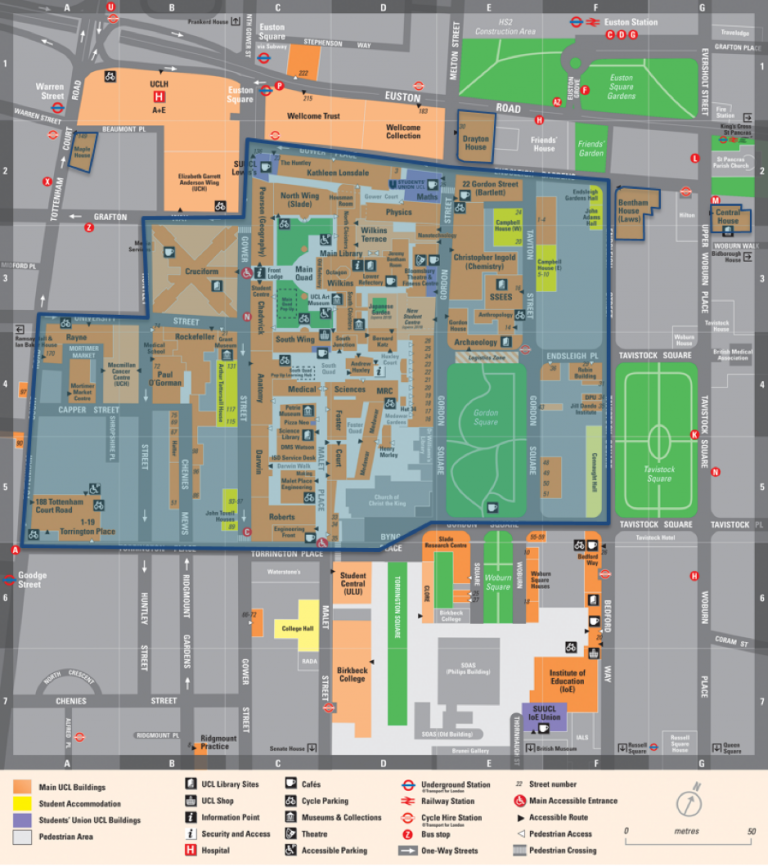The Wireless Expansion project is a five year project aimed at expanding UCL’s wireless coverage and capacity across the Bloomsbury campus.
In response to the feedback received in the recent staff and student IT survey, UCL has been working to boost Wi-Fi coverage and capacity around campus by installing additional wireless access points (WAPs) to extend coverage in areas where there is no Wi-Fi, as well as increasing the number of WAPs to bolster signal in busy areas.
Students and staff will be able to roam seamlessly across the Bloomsbury campus, including open spaces, and make better use of mobile and laptop applications, such as content streaming in HD, with increased capacity in high usage spaces such as lecture theatres and libraries.
The upgrade will also provide UCL operational teams with improved service management tools, allowing easier diagnosis of issues and pinpointing of faulty access points. Network security will be improved as a result too, as well as ensuring UCL’s ability to adapt to the introduction of new technologies in the future.
What’s been done so far?
One comment which came up numerous times from students and staff on the recent IT survey was that Wi-Fi isn’t consistent across the campus and drops out while moving from building to building; especially between residence halls and teaching buildings.
To resolve this, the first step was to bring UCL’s existing wireless infrastructure into alignment by appointing a single supplier. European Electronique (EE) were selected as the wireless system integrator in 2019, and following a successful pilot the project is now in its first phase.
As part of this first phase, you may have seen EE engineers on campus throughout the last few months conducting wireless surveys. These will continue throughout 2020, and engineers will begin access point replacements from January 2020.
Building owners will be contacted directly by the project team help coordinate the changeovers.
Which areas are being upgraded?
The project is targeting 100% coverage across all UCL Bloomsbury buildings and open spaces. The areas highlighted (Fig.1) are the areas the first phase of the project will focus on.
The schedule for the next phase of the project will be published here in due course.

Ask the project a question
If you have any feedback or questions about the Wi-Fi expansion, please feel free to email the project team.
FAQs
Which buildings will you be upgrading the Wi-Fi in?
All buildings on UCL’s Bloomsbury campus will be upgraded to the new wireless infrastructure.
The project is currently in its first phase, which includes upgrading access points in the following buildings:
- 1 St Martins le Grand, St Pauls (Pilot Site)
- Christopher Ingold
- Campbell House West
- Gordon House
- 31-34 Gordon Square
- 14-16 Taviton Street
- Bidborough House
- Student Centre
Following the successful changeover of the above buildings, new Wireless Access Points will be rolled out across the rest of Bloomsbury campus by 2024. The schedule for the following phases will be published here in due course.
Will Wi-Fi be available outside and between buildings?
Yes, the following outdoor spaces now have Wi-Fi:
- Main Quad
- Wilkins Terrace
- Japanese Garden
- South Quad
- Huxley Court
- Malet Place
- Foster Quad
- Medawar Gardens
Work will continue to enable Wi-Fi across remaining outdoor spaces on the Bloomsbury campus.
There are wireless engineers in my building, what are they doing?
Engineers working on the upgrade will be easily identifiable, in company-branded clothes, and will have UCL ID cards.
They may visit your building more than once and could be performing a number of different activities, including surveying the current Wi-Fi set-up and cable routes, replacing access points, or conducting post-installation surveys.
Wireless surveys involve visits to each space, measuring Wi-Fi signal and recording the results. The process should be non-intrusive and only take a few moments. If the WAP is in an occupied teaching room or meeting space the engineers will return later.
My building isn’t on the main Bloomsbury campus, will you be upgrading our Wi-Fi?
Unless driven by Estates refurbishments, buildings outside of the Bloomsbury campus are scheduled to be upgraded after completion of the main campus.
Will the Wi-Fi be down at any point?
No, changeover of individual access points should only take 10-20 minutes.
There may be limited Wi-Fi coverage in the immediate area while the device is being replaced, however there will be good coverage elsewhere in the vicinity.
Will the way I connect to eduroam change?
No, and you should not need to make any changes to your devices.
If you do have any problems connecting to Wi-Fi, you can follow the instructions on the Wi-Fi help page to reconnect, or contact the IT Services if you are experiencing persistent issues.
How long will this take?
The project aims to deliver fully wireless coverage to the Bloomsbury campus by 2024. Due to the variety of buildings across the Bloomsbury campus it’s difficult to provide exact timescales for each site.
How was the new supplier selected?
The project has been through a successful procurement process and the winning design was submitted by European Electronique (EE), one of the market leaders in the education space.
Why do we need to install new access points?
EE are an Aruba system integrator, which is already in use in residence halls. To achieve a consistent service across UCL, work is underway to ensure a smooth and seamless transition of main campus buildings to the new system whilst EE replace existing Cisco WAPs and supporting infrastructure.
Interested in the technical details?
Feel free to email the Wi-Fi expansion project team for more details.
 Close
Close

